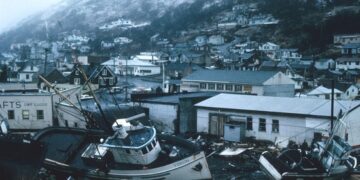Mega-Tsunamis and the United States: Assessing the Reality of the La Palma-Style Threat
A recent scientific study published in the Proceedings of the National Academy of Sciences has reignited concerns over the possibility of mega-tsunamis posing a grave threat to the coastal regions of the United States. Unlike typical tsunamis, which may rise several meters in height, these colossal waves could reach staggering heights of up to 1,000 feet, with the potential to cause catastrophic destruction to vulnerable shorelines and the communities that depend on them.
Geological Hotspots: Regions Most at Risk
Experts have identified key areas of the US most susceptible to such events, including Alaska, Hawaii, and the West Coast. These regions are all characterized by significant geological activity, ranging from seismic tremors to volcanic eruptions. The underlying causes of mega-tsunamis are often linked to massive landslides or seismic disruptions, which can displace enormous volumes of water and generate waves of unprecedented size and force.
The East Coast Concern: The La Palma Volcano Scenario
One of the most talked-about hypotheses regarding mega-tsunamis centers on the Cumbre Vieja volcano located on La Palma in the Canary Islands. This theory, initially proposed by geologists Dr. Simon Day and Dr. Steven Ward in 2001, suggests that a sudden collapse of the volcano’s western flank into the Atlantic Ocean could unleash a colossal tsunami wave. The researchers estimated that the initial wave could tower as high as 2,000 feet near the source, with the potential to maintain a height of approximately 150 feet upon reaching the US East Coast.
Though this scenario remains scientifically debated and controversial, it has attracted considerable public attention, especially after being dramatized in the Netflix series La Palma, which depicts the devastating impact of such a tsunami on coastal communities. Whether or not this event will materialize, the theory underscores the potential for geological events thousands of miles away to have global repercussions.
Alaska’s Precedent: The 1958 Lituya Bay Mega-Tsunami
The reality of mega-tsunamis is not merely theoretical. In 1958, Alaska’s Lituya Bay experienced the largest recorded tsunami in history. Triggered by a massive landslide caused by an earthquake, the resulting wave surged to an astonishing height of 1,719 feet. Eyewitness accounts described an overwhelming roar followed by the devastation of forests and structures, including the miraculous survival of a fisherman whose boat was lifted high enough to clear the treetops.
Alaska remains highly vulnerable due to its rugged, glacier-carved terrain and frequent seismic activity. Compounding these risks, climate change is accelerating glacier melt, increasing the likelihood of destabilizing landslides in the region. This precedent serves as a sobering reminder that mega-tsunamis, while rare, are possible and capable of devastating localized areas.
Hawaii’s Volcanic Risks: Flank Collapses and Tsunami Generation
Hawaii faces its own unique tsunami threats, primarily associated with volcanic activity. Here, the primary danger arises from large sections of volcanic rock potentially breaking off and sliding into the ocean, especially during eruptions or earthquake events. Geological evidence indicates that approximately 105,000 years ago, a mega-tsunami estimated to be around 1,000 feet tall struck the island of Lanai following such a volcanic flank collapse.
Scientists are actively monitoring several volcanoes on the Big Island of Hawaii, including Kilauea and Mauna Loa, which remain volcanically active and have shown signs of structural instability. The potential for sudden flank collapses underscores the necessity for vigilance and preparedness in these regions.
The Cascadia Subduction Zone: West Coast Vulnerabilities
Stretching from northern California to British Columbia, the Cascadia Subduction Zone is one of the most significant geological threats to the US West Coast. This fault line is capable of producing massive earthquakes, and historical records indicate that in the year 1700, a magnitude 9.0 earthquake triggered a tsunami reaching approximately 100 feet in height. This event wiped out coastal forests and left behind what are now referred to as “ghost forests” visible in the region today.
Current assessments by the US Geological Survey (USGS) and the Federal Emergency Management Agency (FEMA) estimate a 37% likelihood of an earthquake between magnitude 8 and 9 occurring within the next 50 years along this fault. Coastal towns such as Tillamook, Astoria, and Newport are particularly at risk of severe flooding and damage should such a tsunami strike. This underscores the urgent need for robust disaster planning and resilient infrastructure.
Preparedness and Mitigation: Planning for the Worst
Given the immense destructive potential of mega-tsunamis, scientists and disaster management officials emphasize the critical importance of monitoring geological activity, improving early warning systems, and educating the public. Although these events are rare, their consequences could be catastrophic, affecting millions of people and causing extensive property damage.
Investing in tsunami detection technology, clear evacuation protocols, and community awareness campaigns are vital steps to mitigate loss of life and property damage. Coastal residents should be informed about the signs of impending tsunamis, such as unusual ocean behavior or seismic activity, and know the quickest routes to safety.
Conclusion
While mega-tsunamis remain low-probability but high-impact events, their potential to cause widespread devastation requires ongoing scientific scrutiny and public preparedness. Regions such as Alaska, Hawaii, and the US West Coast must remain alert to their unique geological risks, while the East Coast cannot entirely dismiss distant threats like the hypothetical La Palma collapse.
Continued research, proactive monitoring, and community education are the best tools to safeguard lives and infrastructure against these rare but devastating natural disasters. The interplay of geological forces reminds us that nature’s power, though sometimes distant, can have direct and profound impacts on our shores.
Also Read : Horoscope Tomorrow May 22, 2025: Predictions for All Zodiac Signs















 Categories
Categories









